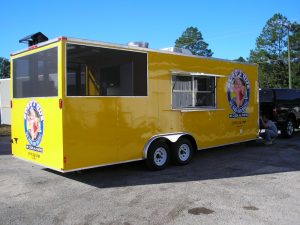Most small restaurants or independent food truck businesses start as one-person enterprises. In the beginning, you’ll find yourself doing not just all of the cooking and cleaning on your new food truck, but taking on a multitude of additional responsibilities.
One day to the next, you may find yourself also fulfilling the roles of accountant, marketing expert, photographer, social media manager, graphic designer, bookkeeper, purchasing manager, billing department, legal analyst, and amateur financial planner.
In order for your business to grow, however, it’s important to realize that it’s impossible to handle every one of these roles by yourself. Eventually, and as the financial stability of your business allows, it will become time to hire help.

BBQ Trailer built by M&R Specialty Trailers and Trucks.
How to make that first hire.
But once you’ve crunched the numbers, and found your ideal candidate, what’s next? How do you set up payroll for the first time, meet all of your legal obligations, and keep your new employee stable, happy, and healthy, without signing over your first-born to your already overworked accountant?
Step 1: Establish a federal tax identification number, or EID. In order to track your payments to employees, the government requires that every business (even sole proprietorships) establish a tax ID number, or EID. There are many shady fly-by-night business compliance services online who will offer to establish a federal tax identification number for you, for a fee. But beware: The IRS provides this service free of charge, and the form you have to fill out is simple and can be completed entirely online.
Step 2: Select a payroll processor. For entrepreneurs, it may make sense to hand over all employee compliance and payroll functions to an accountant. However, this will increase their billable hours considerably, and many of the obligations you need to meet for your new employee can be handled yourself.
With a small staff or just a handful of employees, many online services have emerged who will handle your payroll runs for a flat monthly fee. We recommend a service like Gusto for small businesses just getting started with payroll. Of course, if you’re using Quickbooks to do your accounting, they have a payroll solution as well. Many payment processors (such as Square) also have a payroll add-on that is inexpensive and will handle many of your compliance needs.
Step 3: Establish withholding accounts with your state tax authority. In most states, you’ll need to establish an account with the department of labor or revenue (or equivalent body in your state), to establish an account to which you will make tax withholding payments on behalf of your employees. These payments must be made monthly or quarterly, and are determined by the amount you are paying your employees.
Step 4: File your required “new hire” forms with your state. This will be a little bit different for everyone, depending on where you live. Here in Maine, when we hire a new employee, we’re required to file a form with the state notifying them of the hire, as well as a form that will do a background check on any potential back child support debt that employee may owe. You will also need to register with your state to pay into the unemployment insurance program for your new hire. Again, this will be different from state to state, but should be outlined clearly on your state’s department of labor website.

Step 5: Establish worker’s compensation insurance. In most states, you are required to maintain worker’s compensation insurance for your new employee, in case there is an accident while on the job. This is particularly important in kitchen work, where sharp instruments, fire, and scorching hot surfaces are a regular part of our day-to-day existence.
If an uncovered employee gets hurt on the job, the ensuing lawsuits could put you out of business for good; and remember, your employees are loyal to you and your business, so it’s important to return that loyalty in the form of coverage in case of an accident. Most worker’s compensation policies provide up to $500,000 coverage per incident, for around $50 per month per employee.
While many policies require payment of the full premium in advance, some worker’s compensation insurers are transitioning to a “pay-as-you-go” model that can help keep coverage affordable.
Step 6: Run payroll for the first time, and make sure the IRS gets theirs. Because the IRS always gets theirs. Depending on which payroll provider you choose, many of your various financial obligations for each pay cycle will be handled for you.
At our restaurant, we use Square Payroll for our payroll runs, and I’ve been really happy with how many of the compliance issues they handle for us; it really makes a complicated system of payments to different places easy to manage. Each pay run, Square calculates how much we owe the state for each pay run, and sends the right payments to the right places.
The IRS also takes the money we withhold from each paycheck on behalf of the employee for taxes. This is all handled automatically and with no calculations or intervention on our end. And no, this isn’t a paid advertisement for Square Payroll…I’m just really happy with the service they provide and recommend them to anyone getting started with payroll for the first time.
How Much is A Food Truck Employee Going to Cost?
Having an extra employee or two isn’t going to cost much, right? After all, what’s an extra $11 an hour, when you’re raking in the dough with your new food business? But be careful…there are costs hidden in each employee that can add up quickly.
While a minimum wage employee may not seem like it adds a tremendous amount of cost to your bottom line their compensation doesn’t stop at their hourly rate. Let’s take a look at what the true cost of an employee might be:
- $11/hour * 40 hours per week = $440/week or $22,000/year (So far so good.)
- Social Security Tax: $1,364
- Medicare Tax: $319
- Unemployment Insurance Contribution: $42
- Worker’s Compensation Insurance: $500
Total annual cost for this employee: $24,225
Sure, that may only seem like $2,000 more than you had planned for this employee…but there may even be more costs associated with your employee, depending on where you live.
For example, in Maine, employers must match their employee’s social security tax payments, in the form of a payroll tax, which can make the final cost of an employee 25% higher than a simple calculation of their hourly wage may lead you to believe. Check with your accountant or payroll processor to learn more about the payroll laws specific to your area.
In some states, you also have to pay some form of payroll tax. In Maine, you must pay a payroll tax that’s roughly equal to the social security contributions made by your employees. These filings must be done quarterly, and in Maine, even if you have no employees, you must file with a zero balance due.
It may seem crazy, but these are the kinds of compliance issues you must stay on top of…and if you can’t, hire an accountant or a paralegal to handle these filings on your behalf and keep your new business in good standing.
In general, a good rule of thumb is to assume that an employee will cost you about 1.25 to 1.4 times their actual salary, once all of their taxes and insurance are factored into the equation.
Payroll Processing Fees

There are processing fees for every taco you sell.
Right now, payroll processing fees are all over the map, depending on which company you choose and what their level of service is. A payroll processor like Square Payroll starts at just $35/month plus $5/month per employee, which entitles you to unlimited pay runs for that month.
Different services may charge a flat fee, per employee, or per pay run, so make sure to read the fine print on any agreement before you choose your processor. Having an accountant do the payroll and compliance work could cost anywhere from an extra $200-$500 per month in accountant fees.
Worker’s Compensation Insurance
The cost for worker’s compensation insurance varies slightly, but in general, you can expect to pay around $500 per year for each employee you’re covering. While many insurers will need the premium paid for the entire year in advance, look for worker’s compensation insurers who will allow you to pay per month, or per pay cycle.
This is another area where Square Payroll has excelled for us; they referred us to a broker who found the right policy for us with just a phone call, and the premium is paid automatically from Square during our regular pay runs.
In Conclusion
While the decision to hire your first employee is an incredible milestone for any new business, there’s much more to the process than finding a few spare dollars in your balance sheet to make that new hire. In addition to the extra cost associated with finding help, there are legal and compliance obligations that must be met to keep your new staff members safe, happy, and healthy.
Whether you choose the DIY route, or hire help in the form of accounting or paralegals in order to keep your business compliant, it’s important to work through each of these steps to ensure your business continues to safely grow and expand.

Leave A Comment